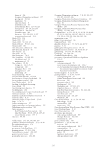17 – ‘Once more into the breach, dear friends …’ 157 modelling indicated significant downstream effects, low flows being particularly vulnerable to proposed low-threshold extraction conditions. Had it not been for a change of government after the state parliamentary election of 1998, the Draft Water Management Plan would have been adopted and an irrigation industry would have been established on the Cooper. From 1998 to 2012 (14 years), the Labor Government in Queensland reversed the direction chosen by the National Party and implemented several important legislative instruments for protection of the Channel Country rivers. The Minister for Natural Resources, Rod Welford, introduced the new Water Management Plan for the Cooper in September 1999, ruling out any new irrigation development or water harvesting, and preserving natural flows almost in their entirety. Existing entitlements (e.g. town water supplies, riparian stock and domestic rights) remained. Subsequent Ministers for Natural Resources, Stephen Robertson, Kate Jones and Vicki Darling, confirmed and strengthened these levels of protection. This direction was slightly altered with the development of a Water Resource Plan for the Georgina–Diamantina system, which allowed 10 000 ML irrigation entitlement (see Chapter 20). This resulted primarily from local pressure to allow for diversification and the support of the water agency, a common theme in the promotion of irrigation development. Otherwise the Georgina– Diamantina Water Management Plan conformed to the 10-year review, which strengthened protection in the Cooper system, with important new controls of overland flow water available under the revised Water Act 2000. In 2011, the greatest level of protection was achieved when the Cooper, Diamantina and Georgina Rivers were declared Wild Rivers under the Wild Rivers Act 2005 (see Chapters 20– 22). Wild River declarations were important legislative instruments which could coordinate and trigger protections for declared rivers and specific areas within an array of other legislation, potentially affecting sustainability, including the Water Act 2000 and its Water Resource Plans, the Sustainable Planning Act 2009, the Environmental Protection Act 1994, and the Mineral Resources Act 1989 (see Chapters 20 and 21). Much of the regulation within the Wild Rivers Act 2005 and Wild River declarations controlling mining and petroleum resource activity was coordinated through corresponding provisions of the Environmental Protection Act 1994. Importantly, the Wild Rivers legislation locked in regulatory controls over water take in the Water Resource Plans. The Wild Rivers Act 2005 and declarations afforded stronger levels of protection according to ecological sensitivity of the river, wetland and floodplain environments in particular areas than other legislation: High Preservation and Special Floodplain Management Areas (see Chapter 20). These regulations controlled or prohibited potentially damaging developments such as intensive agriculture, intensive animal husbandry (feedlots) and, most importantly, mining in the designated areas. They did not impede traditional pastoralism or other industries such as tourism. The coordinated protections afforded under the Wild Rivers Act 2005 were not achievable under piecemeal application of instruments, available under other legislation. Sadly, the state election of 2012 heralded the end of these protections, when the Liberal National Party (2012–15) of Premier Newman, Deputy Premier Seeney and Minister for Natural Resources and Mines, the Honourable Andrew Cripps, introduced a raft of legislative changes repealing
Downloaded from CSIRO with access from at 216.73.216.140 on Nov 22, 2025, 8:39 AM. (c) CSIRO Publishing

















































































































































































































































































